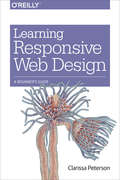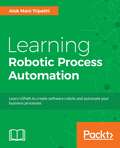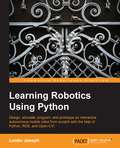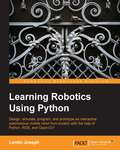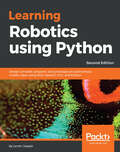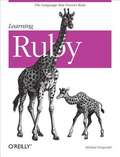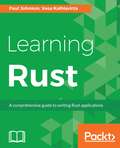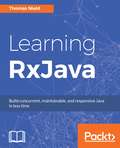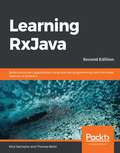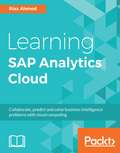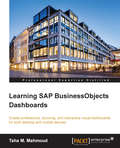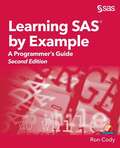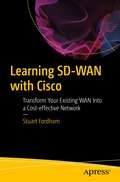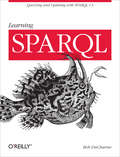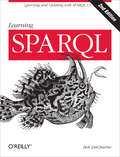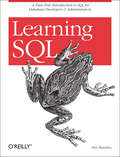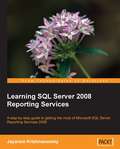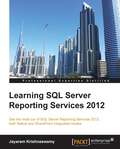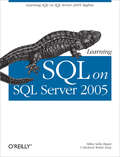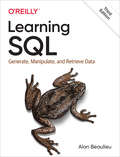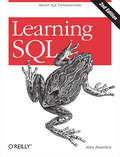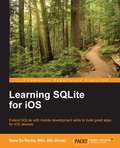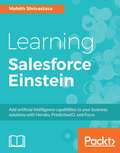- Table View
- List View
Learning Responsive Web Design: A Beginner's Guide
by Clarissa PetersonDeliver an optimal user experience to all devices—including tablets, smartphones, feature phones, laptops, and large screens—by learning the basics of responsive web design. In this hands-on guide, UX designer Clarissa Peterson explains how responsive web design works, and takes you through a responsive workflow from project kickoff to site launch.Ideal for anyone involved in the process of creating websites—not just developers—this book teaches you fundamental strategies and techniques for using HTML and CSS to design websites that not only adapt to any screen size, but also use progressive enhancement to provide a better user experience based on device capabilities such as touchscreens and retina displays.Start with content strategy before creating a visual designLearn why your default design should be for the narrowest screensExplore the HTML elements and CSS properties essential for responsive web designUse media queries to display different CSS styles based on a device’s viewport widthHandle elements such as images, typography, and navigationUse performance optimization techniques to make your site lighter and faster
Learning Robotic Process Automation: Create Software robots and automate business processes with the leading RPA tool – UiPath
by Alok Mani TripathiDesign RPA solutions to perform a wide range of transactional tasks with minimal cost and maximum ROIKey FeaturesA beginner's guide to learn Robotic Process Automation and its impact on the modern worldDesign, test, and perform enterprise automation task with UiPathCreate Automation apps and deploy them to all the computers in your department.Book DescriptionRobotic Process Automation (RPA) enables automating business processes using software robots. Software robots interpret, trigger responses, and communicate with other systems just like humans do. Robotic processes and intelligent automation tools can help businesses improve the effectiveness of services faster and at a lower cost than current methods.This book is the perfect start to your automation journey, with a special focus on one of the most popular RPA tools: UiPath.Learning Robotic Process Automation takes you on a journey from understanding the basics of RPA to advanced implementation techniques. You will become oriented in the UiPath interface and learn about its workflow. Once you are familiar with the environment, we will get hands-on with automating different applications such as Excel, SAP, Windows and web applications, screen and web scraping, working with user events, as well as understanding exceptions and debugging. By the end of the book, you'll not only be able to build your first software bot, but also you'll wire it to perform various automation tasks with the help of best practices for bot deployment.What you will learnUnderstand Robotic Process Automation technologyLearn UiPath programming techniques to deploy robot configurationsExplore various data extraction techniquesLearn about integrations with various popular applications such as SAP and MS OfficeDebug a programmed robot including logging and exception handlingMaintain code version and source controlDeploy and control Bots with UiPath OrchestratorWho this book is forIf you would like to pursue a career in Robotic Process Automation or improve the efficiency of your businesses by automating common tasks, then this book is perfect for you. Prior programming knowledge of either Visual Basic or C# will be useful.
Learning Robotics Using Python
by Lentin JosephIf you are an engineer, a researcher, or a hobbyist, and you are interested in robotics and want to build your own robot, this book is for you. Readers are assumed to be new to robotics but should have experience with Python.
Learning Robotics Using Python
by Lentin Joseph<P><P>Design, simulate, program, and prototype an interactive autonomous mobile robot from scratch with the help of Python, ROS, and Open-CV! <P><P>About This Book <P><P>Design, simulate, build and program an interactive autonomous mobile robot <P><P>Program Robot Operating System using Python <P><P>Get a grip on the hands-on guide to robotics for learning various robotics concepts and build an advanced robot from scratch <P><P>Who This Book Is For <P><P>If you are an engineer, a researcher, or a hobbyist, and you are interested in robotics and want to build your own robot, this book is for you. Readers are assumed to be new to robotics but should have experience with Python. <P><P>What You Will Learn <P><P>Understand the core concepts and terminologies of robotics <P><P>Create 2D and 3D drawings of robots using freeware such as LibreCAD and Blender <P><P>Simulate your robot using ROS and Gazebo <P><P>Build robot hardware from the requirements <P><P>Explore a diverse range of actuators and its interfacing <P><P>Interface various robotic sensors to robots <P><P>Set up and program OpenCV, OpenNI, and PCL to process 2D/3D visual data <P><P>Learn speech processing and synthesis using Python <P><P>Apply artificial intelligence to robots using Python <P><P>Build a robot control GUI using Qt and Python <P><P>Calibration and testing of robot <P><P>In Detail <P><P>Learning about robotics will become an increasingly essential skill as it becomes a ubiquitous part of life. Even though robotics is a complex subject, several other tools along with Python can help you design a project to create an easy-to-use interface. <P><P>Learning Robotics Using Python is an essential guide for creating an autonomous mobile robot using popular robotic software frameworks such as ROS using Python. It also discusses various robot software frameworks and how to go about coding the robot using Python and its framework. It concludes with creating a GUI-based application to control the robot using buttons and slides. <P><P>By the end of this tutorial, you'll have a clear idea of how to integrate and assemble all things into a robot and how to bundle the software package.
Learning Robotics using Python: Design, simulate, program, and prototype an autonomous mobile robot using ROS, OpenCV, PCL, and Python, 2nd Edition
by Lentin JosephDesign, simulate, and program interactive robots Key Features Design, simulate, build, and program an interactive autonomous mobile robot Leverage the power of ROS, Gazebo, and Python to enhance your robotic skills A hands-on guide to creating an autonomous mobile robot with the help of ROS and Python Book Description Robot Operating System (ROS) is one of the most popular robotics software frameworks in research and industry. It has various features for implement different capabilities in a robot without implementing them from scratch. This book starts by showing you the fundamentals of ROS so you understand the basics of differential robots. Then, you'll learn about robot modeling and how to design and simulate it using ROS. Moving on, we'll design robot hardware and interfacing actuators. Then, you'll learn to configure and program depth sensors and LIDARs using ROS. Finally, you'll create a GUI for your robot using the Qt framework. By the end of this tutorial, you'll have a clear idea of how to integrate and assemble everything into a robot and how to bundle the software package. What you will learn Design a differential robot from scratch Model a differential robot using ROS and URDF Simulate a differential robot using ROS and Gazebo Design robot hardware electronics Interface robot actuators with embedded boards Explore the interfacing of different 3D depth cameras in ROS Implement autonomous navigation in ChefBot Create a GUI for robot control Who this book is for This book is for those who are conducting research in mobile robotics and autonomous navigation. As well as the robotics research domain, this book is also for the robot hobbyist community. You're expected to have a basic understanding of Linux commands and Python.
Learning Ruby
by Michael FitzgeraldYou don't have to know everything about a car to drive one, and you don't need to know everything about Ruby to start programming with it. Written for both experienced and new programmers alike, Learning Ruby is a just-get-in-and-drive book -- a hands-on tutorial that offers lots of Ruby programs and lets you know how and why they work, just enough to get you rolling down the road. Interest in Ruby stems from the popularity of Rails, the web development framework that's attracting new devotees and refugees from Java and PHP. But there are plenty of other uses for this versatile language. The best way to learn is to just try the code! You'll find examples on nearly every page of this book that you can imitate and hack. Briefly, this book:Outlines many of the most important features of Ruby Demonstrates how to use conditionals, and how to manipulate strings in Ruby. Includes a section on regular expressions Describes how to use operators, basic math, functions from the Math module, rational numbers, etc. Talks you through Ruby arrays, and demonstrates hashes in detail Explains how to process files with Ruby Discusses Ruby classes and modules (mixins) in detail, including a brief introduction to object-oriented programming (OOP) Introduces processing XML, the Tk toolkit, RubyGems, reflection, RDoc, embedded Ruby, metaprogramming, exception handling, and other topics Acquaints you with some of the essentials of Rails, and includes a short Rails tutorial. Each chapter concludes with a set of review questions, and appendices provide you with a glossary of terms related to Ruby programming, plus reference material from the book in one convenient location. If you want to take Ruby out for a drive, Learning Ruby holds the keys.
Learning Ruby
by Michael James FitzgeraldYou don't have to know everything about a car to drive one, and you don't need to know everything about Ruby to start programming with it. Written for both experienced and new programmers alike, Learning Ruby is a just-get-in-and-drive book -- a hands-on tutorial that offers lots of Ruby programs and lets you know how and why they work, just enough to get you rolling down the road. Interest in Ruby stems from the popularity of Rails, the web development framework that's attracting new devotees and refugees from Java and PHP. But there are plenty of other uses for this versatile language. The best way to learn is to just try the code! You'll find examples on nearly every page of this book that you can imitate and hack. Briefly, this book: * Outlines many of the most important features of Ruby * Demonstrates how to use conditionals, and how to manipulate strings in Ruby. Includes a section on regular expressions * Describes how to use operators, basic math, functions from the Math module, rational numbers, etc. * Talks you through Ruby arrays, and demonstrates hashes in detail * Explains how to process files with Ruby * Discusses Ruby classes and modules (mixins) in detail, including a brief introduction to object-oriented programming (OOP) * Introduces processing XML, the Tk toolkit, RubyGems, reflection, RDoc, embedded Ruby, metaprogramming, exception handling, and other topics * Acquaints you with some of the essentials of Rails, and includes a short Rails tutorial. Each chapter concludes with a set of review questions, and appendices provide you with a glossary of terms related to Ruby programming, plus reference material from the book in one convenient location. If you want to take Ruby out for a drive, Learning Ruby holds the keys.
Learning Rust
by Paul Johnson Vesa KaihlavirtaStart building fast and robust applications with the power of Rust by your side About This Book • Get started with the language to build scalable and high performance applications • This book will help C#/C++ developers gain better performance and memory management • Discover the power of Rust when developing concurrent applications for large and scalable software Who This Book Is For The book is for absolute beginners to Rust, who want to build high performance, concurrent applications for their projects. It is suitable for developers who have a basic knowledge of programming and developers who are using the C#/C++ language to write their applications. No knowledge of Rust is expected. What You Will Learn • Set up Rust for Windows, Linux, and OS X • Write effective code using Rust • Expand your Rust applications using libraries • Interface existing non-Rust libraries with your Rust applications • Use the standard library within your applications • Understand memory management within Rust and speed efficiency when passing variables • Create more complex data types • Study concurrency in Rust with multi-threaded applications and sync threading techniques to improve the performance of an application problem In Detail Rust is a highly concurrent and high performance language that focuses on safety and speed, memory management, and writing clean code. It also guarantees thread safety, and its aim is to improve the performance of existing applications. Its potential is shown by the fact that it has been backed by Mozilla to solve the critical problem of concurrency. Learning Rust will teach you to build concurrent, fast, and robust applications. From learning the basic syntax to writing complex functions, this book will is your one stop guide to get up to speed with the fundamentals of Rust programming. We will cover the essentials of the language, including variables, procedures, output, compiling, installing, and memory handling. You will learn how to write object-oriented code, work with generics, conduct pattern matching, and build macros. You will get to know how to communicate with users and other services, as well as getting to grips with generics, scoping, and more advanced conditions. You will also discover how to extend the compilation unit in Rust. By the end of this book, you will be able to create a complex application in Rust to move forward with. Style and approach This comprehensive book will focus on the Rust syntax, functions, data types, and conducting pattern matching for programmers. It is divided into three parts and each part of the book has an objective to enable the readers to create their own applications at an appropriate level, ultimately towards creating complex applications.
Learning RxJava
by Thomas NieldReactive Programming with Java and ReactiveX About This Book • Explore the essential tools and operators RxJava provides, and know which situations to use them in • Delve into Observables and Subscribers, the core components of RxJava used for building scalable and performant reactive applications • Delve into the practical implementation of tools to effectively take on complex tasks such as concurrency and backpressure Who This Book Is For The primary audience for this book is developers with at least a fundamental mastery of Java. Some readers will likely be interested in RxJava to make programs more resilient, concurrent, and scalable. Others may be checking out reactive programming just to see what it is all about, and to judge whether it can solve any problems they may have. What You Will Learn • Learn the features of RxJava 2 that bring about many significant changes, including new reactive types such as Flowable, Single, Maybe, and Completable • Understand how reactive programming works and the mindset to "think reactively" • Demystify the Observable and how it quickly expresses data and events as sequences • Learn the various Rx operators that transform, filter, and combine data and event sequences • Leverage multicasting to push data to multiple destinations, and cache and replay them • Discover how concurrency and parallelization work in RxJava, and how it makes these traditionally complex tasks trivial to implement • Apply RxJava and Retrolambda to the Android domain to create responsive Android apps with better user experiences • Use RxJava with the Kotlin language to express RxJava more idiomatically with extension functions, data classes, and other Kotlin features In Detail RxJava is a library for composing asynchronous and event-based programs using Observable sequences for the JVM, allowing developers to build robust applications in less time. Learning RxJava addresses all the fundamentals of reactive programming to help readers write reactive code, as well as teach them an effective approach to designing and implementing reactive libraries and applications. Starting with a brief introduction to reactive programming concepts, there is an overview of Observables and Observers, the core components of RxJava, and how to combine different streams of data and events together. You will also learn simpler ways to achieve concurrency and remain highly performant, with no need for synchronization. Later on, we will leverage backpressure and other strategies to cope with rapidly-producing sources to prevent bottlenecks in your application. After covering custom operators, testing, and debugging, the book dives into hands-on examples using RxJava on Android as well as Kotlin. Style and approach This book will be different from other Rx books, taking an approach that comprehensively covers Rx concepts and practical applications.
Learning RxJava: Build concurrent applications using reactive programming with the latest features of RxJava 3, 2nd Edition
by Thomas Nield Nick SamoylovUpdated with the latest Maven coordinates, Java programming features, and API changes, this book is your guide to solving problems in writing asynchronous and event-based programs Key Features Explore a variety of tools and techniques used to solve problems in implementing concurrency and parallelization Learn about core operators in RxJava that enable you to express your code logic productively Apply RxJava with Kotlin to create responsive Android apps with better user experience Book Description RxJava is not just a popular library for building asynchronous and event-based applications; it also enables you to create a cleaner and more readable code base. In this book, you'll cover the core fundamentals of reactive programming and learn how to design and implement reactive libraries and applications. Learning RxJava will help you understand how reactive programming works and guide you in writing your first example in reactive code. You'll get to grips with the workings of Observable and Subscriber, and see how they are used in different contexts using real-world use cases. The book will also take you through multicasting and caching to help prevent redundant work with multiple Observers. You'll then learn how to create your own RxJava operators by reusing reactive logic. As you advance, you'll explore effective tools and libraries to test and debug RxJava code. Finally, you'll delve into RxAndroid extensions and use Kotlin features to streamline your Android apps. By the end of this book, you'll become proficient in writing reactive code in Java and Kotlin to build concurrent applications, including Android applications. What you will learn Discover different ways to create Observables, Observers, and Subscribers Multicast in order to push data to multiple destinations and cache and replay them Express RxJava idiomatically with the help of Kotlin features such as extension functions and data classes Become familiar with various operators available in RxJava to perform common transformations and tasks Explore RxJava's reactive types, including Flowable, Single, Maybe, and Completable Demystify Observables and how they express data and events as sequences Who this book is for This book is for Java developers who want to leverage reactive programming to develop more resilient and concurrent applications. If you're an RxJava user looking to get to grips with the latest features and updates in RxJava 3, this book is for you. Fundamental knowledge of core Java features and object-oriented programming will assist you in understanding the key concepts covered in this book.
Learning SAP Analytics Cloud
by Riaz AhmedStart making better business decisions backed by data About This Book • Predict new opportunities and risks in a few mouse clicks • Eliminate complexity with tools that let you plan, analyze, and collaborate in context—in real time • Discover, visualize, plan, and predict in a single product with agile BI tools Who This Book Is For This book targets IT professionals, business analysts, BI developers, managers, newcomers to SAP Analytics Cloud, and ultimately anyone who wants to learn from self-paced, professional guidance and needs a solid foundation in SAP Analytics Cloud. What You Will Learn • A clear understanding of SAP Analytics Cloud platform • Create data models using different data sources, including Excel and text files . • Present professional analyses using different types of charts, tables, geo maps, and more • Using stories, drill up and down instantly to analyze data from various angles • Share completed stories with other team members or compile them in SAP Digital Boardroom agendas for presentation to major stakeholders • Export the results of a story to a PDF file • Save time by planning, analyzing, predicting, and collaborating in context • Discover, visualize, plan, and predict in one product as opposed to separate solutions In Detail The book starts with the basics of SAP Analytics Cloud (formerly known as SAP BusinessObjects Cloud) and exposes almost every significant feature a beginner needs to master. Packed with illustrations and short, essential, to-the-point descriptions, the book provides a unique learning experience. Your journey of exploration starts with a basic introduction to the SAP Analytics Cloud platform. You will then learn about different segments of the product, such as Models, Stories, Digital Boardroom, and so on. Then, you are introduced to the product's interface: the Home screen, the main menu, and more. Then comes the hands-on aspect of the book, which starts with model creation. Next, you learn how to utilize a model to prepare different types of stories(reports) with the help of charts, tables, Geo Maps, and more. In the final chapters of this book, you will learn about Digital Boardroom, Collaboration, and Administration. Style and approach The easy-to-follow visual instructions provided in this book help business users and report developers create simple and complex stories (reports) quickly
Learning SAP BusinessObjects Dashboards
by Taha M. MahmoudThis book will help beginners to create stylish and professional looking dashboards in no time. It is also intended for BI developers who want to use SAP BO to facilitate BI in their organizations. No prior knowledge is required, however, you must have a basic knowledge of MS Excel and some analytical skills to build expressive business charts.
Learning SAS by Example: A Programmer's Guide
by Ron CodyLearn to program SAS by example! Learning SAS by Example: A Programmer’s Guide, Second Edition, teaches SAS programming from very basic concepts to more advanced topics. Because most programmers prefer examples rather than reference-type syntax, this book uses short examples to explain each topic. The second edition has brought this classic book on SAS programming up to the latest SAS version, with new chapters that cover topics such as PROC SGPLOT and Perl regular expressions. This book belongs on the shelf (or e-book reader) of anyone who programs in SAS, from those with little programming experience who want to learn SAS to intermediate and even advanced SAS programmers who want to learn new techniques or identify new ways to accomplish existing tasks. <P><P>In an instructive and conversational tone, author Ron Cody clearly explains each programming technique and then illustrates it with one or more real-life examples, followed by a detailed description of how the program works. The text is divided into four major sections: Getting Started, DATA Step Processing, Presenting and Summarizing Your Data, and Advanced Topics. Subjects addressed include
Learning SD-WAN with Cisco: Transform Your Existing WAN Into a Cost-effective Network
by Stuart FordhamExplore the rise of SD-WAN with CISCO and transform your existing WAN into an agile, efficient, and cost-effective network. Learning SD-WAN with Cisco helps you understand the development of SD-WAN and its benefits to modern networks. This book starts with an exploration of the different components of SD-WAN, such as vBond for orchestration, vManage for management, vSmart for control, and the vEdge devices. From there, it moves on to building a network from the ground up using EVE-NG, focusing on how to install EVE-NG, get the required licenses via a SmartNET account, download the components, and begin to create your network by installing vManage.Once you have this foundation, you will create the organization and certificates, and look at local users as well as single- and multi-tenancy options and clustering. As you continue to build your network, you will dig down into the overlay protocols used in SD-WAN, and then deploy your controllers and edge devices, looking at zero-touch provisioning along the way.After building your network, you will configure and apply policies and templates to manage the control and data planes as well as VPNs, Internet access, security, and quality of service. The book also explores reporting and management using vManage, along with upgrading and troubleshooting the various components, using techniques from simple ping and trace route through to advanced techniques such as DTLS and TLOC troubleshooting and traffic simulation.After reading this book, you will have hands-on experience working with SD-WAN. You will understand how to deploy, configure, manage, and troubleshoot it.What You Will LearnKnow what SD-WAN is, how it came about, and why we need itUnderstand troubleshooting and traffic simulation of DTLS and TLOC Monitor, report, and troubleshoot the SD-WAN environment Who This Book Is For Network professionals with experience in Linux and Cisco devices
Learning SPARQL
by Bob DuCharmeGet hands-on experience with SPARQL, the RDF query language that's become a key component of the semantic web. With this concise book, you will learn how to use the latest version of this W3C standard to retrieve and manipulate the increasing amount of public and private data available via SPARQL endpoints. Several open source and commercial tools already support SPARQL, and this introduction gets you started right away.Begin with how to write and run simple SPARQL 1.1 queries, then dive into the language's powerful features and capabilities for manipulating the data you retrieve. Learn what you need to know to add to, update, and delete data in RDF datasets, and give web applications access to this data.Understand SPARQL’s connection with RDF, the semantic web, and related specificationsQuery and combine data from local and remote sourcesCopy, convert, and create new RDF dataLearn how datatype metadata, standardized functions, and extension functions contribute to your queriesIncorporate SPARQL queries into web-based applications
Learning SPARQL: Querying and Updating with SPARQL 1.1
by Bob DuCharmeGain hands-on experience with SPARQL, the RDF query language that’s bringing new possibilities to semantic web, linked data, and big data projects. This updated and expanded edition shows you how to use SPARQL 1.1 with a variety of tools to retrieve, manipulate, and federate data from the public web as well as from private sources.Author Bob DuCharme has you writing simple queries right away before providing background on how SPARQL fits into RDF technologies. Using short examples that you can run yourself with open source software, you’ll learn how to update, add to, and delete data in RDF datasets.Get the big picture on RDF, linked data, and the semantic webUse SPARQL to find bad data and create new data from existing dataUse datatype metadata and functions in your queriesLearn techniques and tools to help your queries run more efficientlyUse RDF Schemas and OWL ontologies to extend the power of your queriesDiscover the roles that SPARQL can play in your applications
Learning SQL
by Alan BeaulieuUpdated for the latest database management systems -- including MySQL 6.0, Oracle 11g, and Microsoft's SQL Server 2008 -- this introductory guide will get you up and running with SQL quickly. Whether you need to write database applications, perform administrative tasks, or generate reports, Learning SQL, Second Edition, will help you easily master all the SQL fundamentals. Each chapter presents a self-contained lesson on a key SQL concept or technique, with numerous illustrations and annotated examples. Exercises at the end of each chapter let you practice the skills you learn. With this book, you will: Move quickly through SQL basics and learn several advanced features Use SQL data statements to generate, manipulate, and retrieve data Create database objects, such as tables, indexes, and constraints, using SQL schema statements Learn how data sets interact with queries, and understand the importance of subqueries Convert and manipulate data with SQL's built-in functions, and use conditional logic in data statements Knowledge of SQL is a must for interacting with data. With Learning SQL, you'll quickly learn how to put the power and flexibility of this language to work.
Learning SQL
by Alan BeaulieuSQL (Structured Query Language) is a standard programming language for generating, manipulating, and retrieving information from a relational database. If you're working with a relational database--whether you're writing applications, performing administrative tasks, or generating reports--you need to know how to interact with your data. Even if you are using a tool that generates SQL for you, such as a reporting tool, there may still be cases where you need to bypass the automatic generation feature and write your own SQL statements.To help you attain this fundamental SQL knowledge, look to Learning SQL, an introductory guide to SQL, designed primarily for developers just cutting their teeth on the language. Learning SQL moves you quickly through the basics and then on to some of the more commonly used advanced features. Among the topics discussed:The history of the computerized databaseSQL Data Statements--those used to create, manipulate, and retrieve data stored in your database; example statements include select, update, insert, and deleteSQL Schema Statements--those used to create database objects, such as tables, indexes, and constraintsHow data sets can interact with queriesThe importance of subqueriesData conversion and manipulation via SQL's built-in functionsHow conditional logic can be used in Data StatementsBest of all, Learning SQL talks to you in a real-world manner, discussing various platform differences that you're likely to encounter and offering a series of chapter exercises that walk you through the learning process. Whenever possible, the book sticks to the features included in the ANSI SQL standards. This means you'll be able to apply what you learn to any of several different databases; the book covers MySQL, Microsoft SQL Server, and Oracle Database, but the features and syntax should apply just as well (perhaps with some tweaking) to IBM DB2, Sybase Adaptive Server, and PostgreSQL.Put the power and flexibility of SQL to work. With Learning SQL you can master this important skill and know that the SQL statements you write are indeed correct.
Learning SQL Server 2008 Reporting Services
by Jayaram KrishnaswamyWith clear instructions and plenty of screenshots, this book provides all the support and guidance you will need as you begin to generate reports with SQL Server 2008 Reporting Services. This book is for anyone who is new to SQL Server 2008 Reporting Services and needs to create and deploy reports. The book is suitable for report developers, data analysts, and report server database administrators. You will need to know the basic concepts of SQL Server, but not necessarily be very familiar with SQL Server 2008.
Learning SQL Server Reporting Services 2012
by Jayaram KrishnaswamyThe book is packed with clear instructions and plenty of screenshots, providing all the support and guidance you will need as you begin to generate reports with SQL Server 2012 Reporting Services.This book is for those who are new to SQL Server Reporting Services 2012 and aspiring to create and deploy cutting edge reports. This book is for report developers, report authors, ad-hoc report authors and model developers, and Report Server and SharePoint Server Integrated Report Server administrators. Minimal knowledge of SQL Server is assumed and SharePoint experience would be helpful.
Learning SQL on SQL Server 2005
by Sikha Saha Bagui Richard Walsh EarpAnyone who interacts with today's modern databases needs to know SQL (Structured Query Language), the standard language for generating, manipulating, and retrieving database information. In recent years, the dramatic rise in the popularity of relational databases and multi-user databases has fueled a healthy demand for application developers and others who can write SQL code efficiently and correctly. If you're new to databases, or need a SQL refresher, Learning SQL on SQL Server 2005 is an ideal step-by-step introduction to this database query tool, with everything you need for programming SQL using Microsoft's SQL Server 2005-one of the most powerful and popular database engines used today. Plenty of books explain database theory. This guide lets you apply the theory as you learn SQL. You don't need prior database knowledge, or even prior computer knowledge. Based on a popular university-level course designed by authors Sikha Saha Bagui and Richard Walsh Earp, Learning SQL on SQL Server 2005 starts with very simple SQL concepts, and slowly builds into more complex query development. Every topic, concept, and idea comes with examples of code and output, along with exercises to help you gain proficiency in SQL and SQL Server 2005. With this book, you'll learn:Beginning SQL commands, such as how and where to type an SQL query, and how to create, populate, alter and delete tablesHow to customize SQL Server 2005's settings and about SQL Server 2005's functionsAbout joins, a common database mechanism for combining tablesQuery development, the use of views and other derived structures, and simple set operationsSubqueries, aggregate functions and correlated subqueries, as well as indexes and constraints that can be added to tables in SQL Server 2005 Whether you're an undergraduate computer science or MIS student, a self-learner who has access to the new Microsoft database, or work for your company's IT department, Learning SQL on SQL Server 2005 will get you up to speed on SQL in no time.
Learning SQL: Generate, Manipulate, and Retrieve Data
by Alan BeaulieuAs data floods into your company, you need to put it to work right away—and SQL is the best tool for the job. With the latest edition of this introductory guide, author Alan Beaulieu helps developers get up to speed with SQL fundamentals for writing database applications, performing administrative tasks, and generating reports. You’ll find new chapters on SQL and big data, analytic functions, and working with very large databases.Each chapter presents a self-contained lesson on a key SQL concept or technique using numerous illustrations and annotated examples. Exercises let you practice the skills you learn. Knowledge of SQL is a must for interacting with data. With Learning SQL, you’ll quickly discover how to put the power and flexibility of this language to work.Move quickly through SQL basics and several advanced featuresUse SQL data statements to generate, manipulate, and retrieve dataCreate database objects, such as tables, indexes, and constraints with SQL schema statementsLearn how datasets interact with queries; understand the importance of subqueriesConvert and manipulate data with SQL’s built-in functions and use conditional logic in data statements
Learning SQL: Master SQL Fundamentals
by Alan BeaulieuUpdated for the latest database management systems -- including MySQL 6.0, Oracle 11g, and Microsoft's SQL Server 2008 -- this introductory guide will get you up and running with SQL quickly. Whether you need to write database applications, perform administrative tasks, or generate reports, Learning SQL, Second Edition, will help you easily master all the SQL fundamentals.Each chapter presents a self-contained lesson on a key SQL concept or technique, with numerous illustrations and annotated examples. Exercises at the end of each chapter let you practice the skills you learn. With this book, you will:Move quickly through SQL basics and learn several advanced featuresUse SQL data statements to generate, manipulate, and retrieve dataCreate database objects, such as tables, indexes, and constraints, using SQL schema statementsLearn how data sets interact with queries, and understand the importance of subqueriesConvert and manipulate data with SQL's built-in functions, and use conditional logic in data statementsKnowledge of SQL is a must for interacting with data. With Learning SQL, you'll quickly learn how to put the power and flexibility of this language to work.
Learning SQLite for iOS
by Msc Gene Da RochaExtend SQLite with mobile development skills to build great apps for iOS devices About This Book * Implement Swift code using SQLite statements * Learn the background to SQL and SQLite for mobile development, its statements, and command features through practical examples * Extend the standard SQLite functionality and increase your software creation portfolio Who This Book Is For This book is intended for those who want to learn about SQLite and how to develop apps in Swift or HTML5 using SQLite. Whether you are an expert Objective-C programmer or new to this platform, you'll learn quickly, grasping the code in real-world apps to use Swift. What You Will Learn * Explore Swift's basic language statements * Connect to SQLite and execute SQL statements * Extend the SQLite language to create your own software extensions * Use HTML5 with Phonegap on iOS * Set up a Swift project using XCode with SQLite * Administer SQLite databases in an easy and effective way In Detail The ability to use SQLite with iOS provides a great opportunity to build amazing apps. Apple's iOS SDK provides native support for SQLite databases. This combination offers the potential to create powerful, data-persistent applications. This book starts with the architecture of SQLite database and introduces you to concepts in SQL . You will find yourself equipped to design your own database system, administer it, and maintain it. Further, you will learn how to operate your SQLite databases smoothly using SQL commands. You will be able to extend the functionality of SQLite by using its vast arsenal of C API calls to build some interesting, exciting, new, and intelligent data-driven applications. Understand how Xcode, HTML5, and Phonegap can be used to build a cross-platform modern app which can benefit from all these technologies - all through creating a complete, customizable application skeleton that you can build on for your own apps. Style and approach This book is a practical and comprehensive guide to developing applications using SQLite and iOS.
Learning Salesforce Einstein
by Mohith ShrivastavaIncorporate the power of Einstein in your Salesforce application About This Book • Make better predictions of your business processes using prediction and predictive modeling • Build your own custom models by leveraging PredictionIO on the Heroku platform • Integrate Einstein into various cloud services to predict sales, marketing leads, insights into news feeds, and more Who This Book Is For This book is for developers, data scientists, and Salesforce-experienced consultants who want to explore Salesforce Einstein and its current offerings. It assumes some prior experience with the Salesforce platform. What You Will Learn • Get introduced to AI and its role in CRM and cloud applications • Understand how Einstein works for the sales, service, marketing, community, and commerce clouds • Gain a deep understanding of how to use Einstein for the analytics cloud • Build predictive apps on Heroku using PredictionIO, and work with Einstein Predictive Vision Services • Incorporate Einstein in the IoT cloud • Test the accuracy of Einstein through Salesforce reporting and Wave analytics In Detail Dreamforce 16 brought forth the latest addition to the Salesforce platform: an AI tool named Einstein. Einstein promises to provide users of all Salesforce applications with a powerful platform to help them gain deep insights into the data they work on. This book will introduce you to Einstein and help you integrate it into your respective business applications based on the Salesforce platform. We start off with an introduction to AI, then move on to look at how AI can make your CRM and apps smarter. Next, we discuss various out-of-the-box components added to sales, service, marketing, and community clouds from salesforce to add Artificial Intelligence capabilities. Further on, we teach you how to use Heroku, PredictionIO, and the force.com platform, along with Einstein, to build smarter apps. The core chapters focus on developer content and introduce PredictionIO and Salesforce Einstein Vision Services. We explore Einstein Predictive Vision Services, along with analytics cloud, the Einstein Data Discovery product, and IOT core concepts. Throughout the book, we also focus on how Einstein can be integrated into CRM and various clouds such as sales, services, marketing, and communities. By the end of the book, you will be able to embrace and leverage the power of Einstein, incorporating its functions to gain more knowledge. Salesforce developers will be introduced to the world of AI, while data scientists will gain insights into Salesforce's various cloud offerings and how they can use Einstein's capabilities and enhance applications. Style and approach This book takes a straightforward approach to explain Salesforce Einstein and all of its potential applications. Filled with examples, the book presents the facts along with seasoned advice and real-world use cases to ensure you have all the resources you need to incorporate the power of Einstein in your work.
